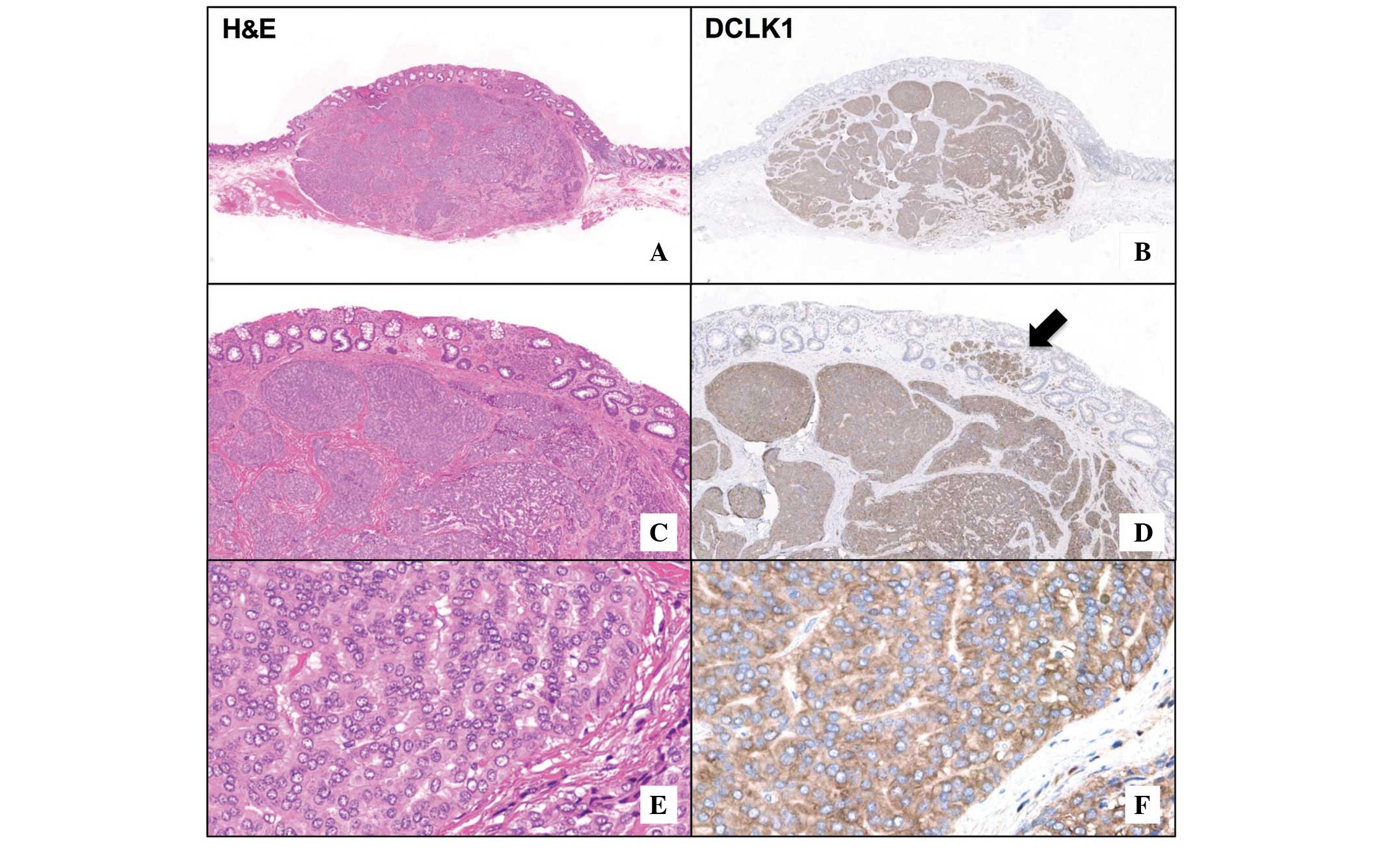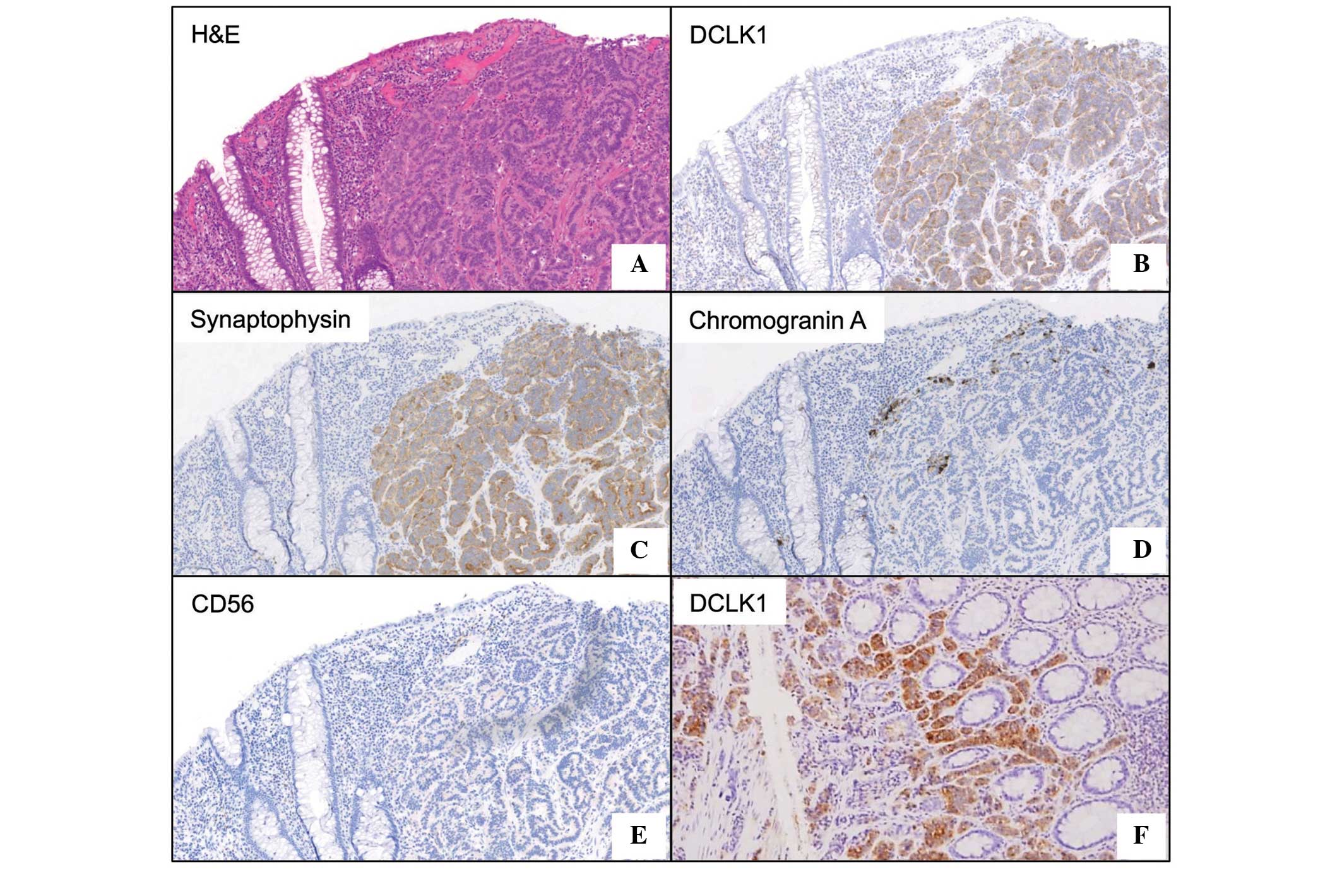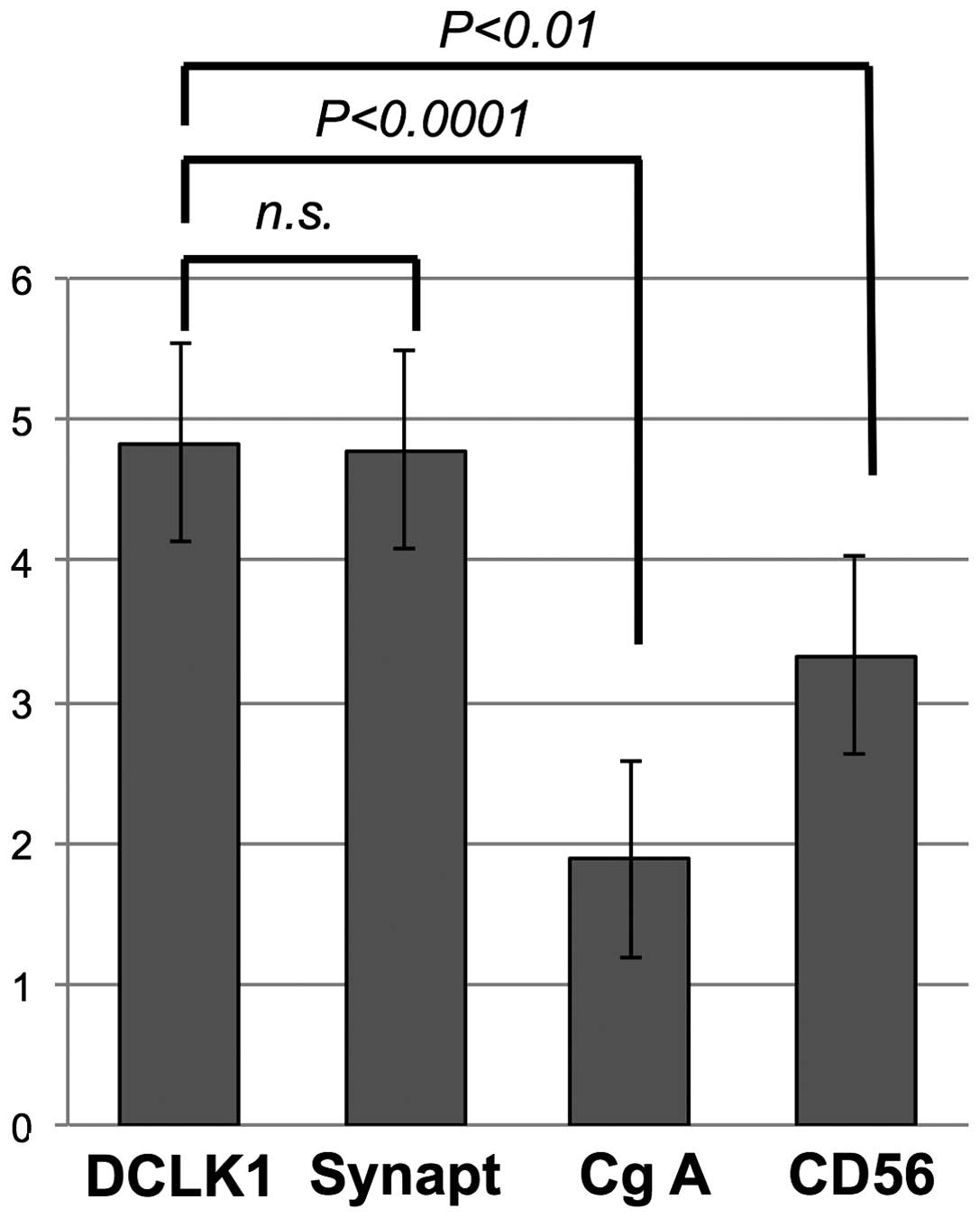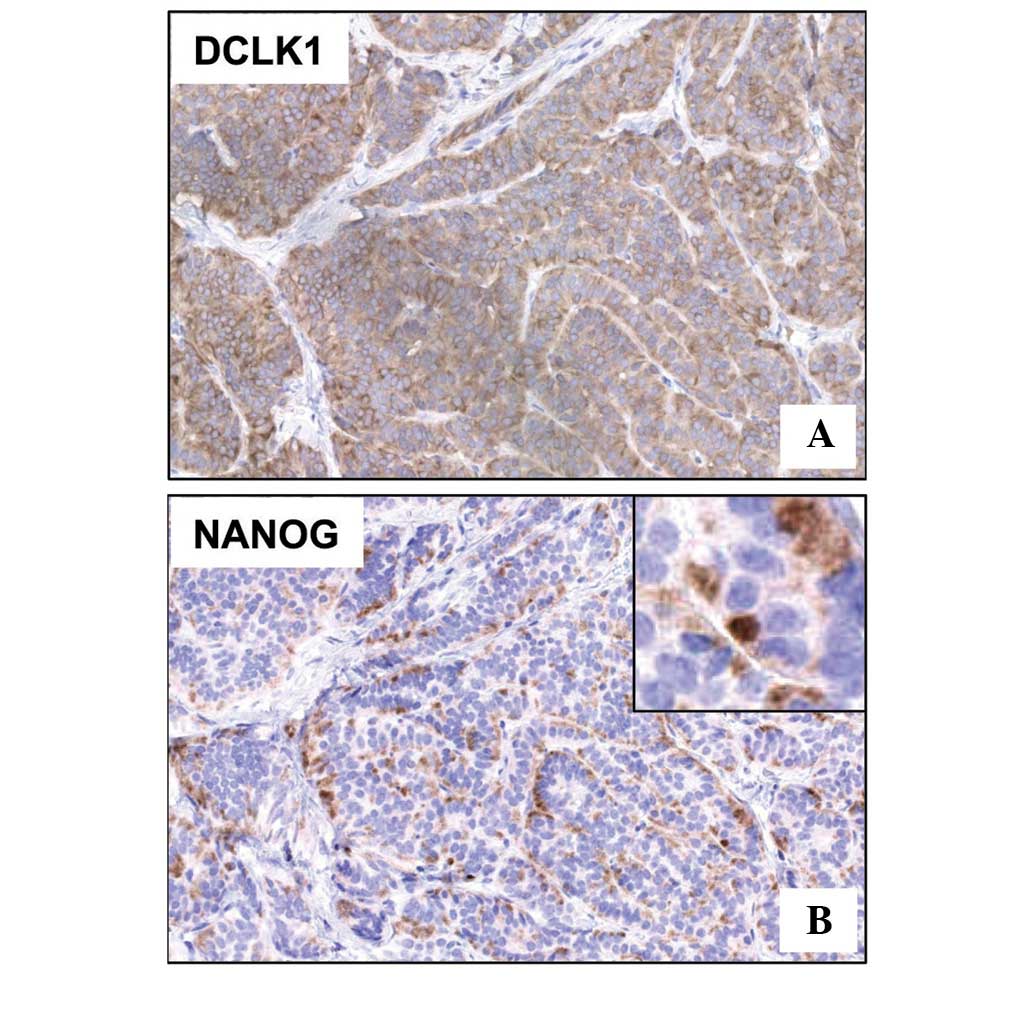|
1
|
Pearse AG: The diffuse neuroendocrine
system and the apud concept: Related ‘endocrine’ peptides in brain,
intestine, pituitary, placenta, and anuran cutaneous glands. Med
Biol. 55:115–125. 1977.PubMed/NCBI
|
|
2
|
Ito T, Igarashi H, Nakamura K, Sasano H,
Okusaka T, Takano K, Komoto I, Tanaka M, Imamura M, Jensen RT, et
al: Epidemiological trends of pancreatic and gastrointestinal
neuroendocrine tumors in Japan: A nationwide survey analysis. J
Gastroenterol. 50:58–64. 2015. View Article : Google Scholar : PubMed/NCBI
|
|
3
|
Tsikitis VL, Wertheim BC and Guerrero MA:
Trends of incidence and survival of gastrointestinal neuroendocrine
tumors in the United States: A seer analysis. J Cancer. 3:292–302.
2012. View
Article : Google Scholar : PubMed/NCBI
|
|
4
|
Soga J: Carcinoids and their variant
endocrinomas. An analysis of 11842 reported cases. J Exp Clin
Cancer Res. 22:517–530. 2003.PubMed/NCBI
|
|
5
|
Konishi T, Watanabe T, Kishimoto J, Kotake
K, Muto T and Nagawa H: Japanese Society for Cancer of the Colon
and Rectum: Prognosis and risk factors of metastasis in colorectal
carcinoids: Results of a nationwide registry over 15-years. Gut.
56:863–868. 2007. View Article : Google Scholar : PubMed/NCBI
|
|
6
|
Oberndorfer S: Karzinoide Tumoren des
Dünndarms. Frankf Z Pathol. 1:426–432. 1907.
|
|
7
|
Rindi G, Arnold R, Bosman FT, et al:
Nomenclature and classification of neuroendocrine neoplasms of
digestive systemWHO Classification of Tumours of the Digestive
System. Bosman FT, Carneiro F, Hruban R and Theise ND: 4th. IARC;
Lyon, France: pp. 13–14. 2010
|
|
8
|
Jann H, Roll S, Couvelard A, Hentic O,
Pavel M, Müller-Nordhorn J, Koch M, Röcken C, Rindi G, Ruszniewski
P, et al: Neuroendocrine tumors of midgut and hindgut origin:
Tumor-node-metastasis classification determines clinical outcome.
Cancer. 117:3332–3341. 2011. View Article : Google Scholar : PubMed/NCBI
|
|
9
|
Shu T, Tseng HC, Sapir T, Stern P, Zhou Y,
Sanada K, Fischer A, Coquelle FM, Reiner O and Tsai LH:
Doublecortin-like kinase controls neurogenesis by regulating
mitotic spindles and M phase progression. Neuron. 49:25–39. 2006.
View Article : Google Scholar : PubMed/NCBI
|
|
10
|
Koizumi H, Tanaka T and Gleeson JG:
Doublecortin-like kinase functions with doublecortin to mediate
fiber tract decussation and neuronal migration. Neuron. 49:55–66.
2006. View Article : Google Scholar : PubMed/NCBI
|
|
11
|
Koizumi H, Higginbotham H, Poon T, Tanaka
T, Brinkman BC and Gleeson JG: Doublecortin maintains bipolar shape
and nuclear translocation during migration in the adult forebrain.
Nat Neurosci. 9:779–786. 2006. View
Article : Google Scholar : PubMed/NCBI
|
|
12
|
Verissimo CS, Molenaar JJ, Meerman J,
Puigvert JC, Lamers F, Koster J, Danen EH, van de Water B, Versteeg
R, Fitzsimons CP, et al: Silencing of the microtubule-associated
proteins doublecortin-like and doublecortin-like kinase-long
induces apoptosis in neuroblastoma cells. Endocr Relat Cancer.
17:399–414. 2010. View Article : Google Scholar : PubMed/NCBI
|
|
13
|
Giannakis M, Stappenbeck TS, Mills JC,
Leip DG, Lovett M, Clifton SW, Ippolito JE, Glasscock JI, Arumugam
M, Brent MR, et al: Molecular properties of adult mouse gastric and
intestinal epithelial progenitors in their niches. J Biol Chem.
281:11292–11300. 2006. View Article : Google Scholar : PubMed/NCBI
|
|
14
|
May R, Sureban SM, Lightfoot SA, Hoskins
AB, Brackett DJ, Postier RG, Ramanujam R, Rao CV, Wyche JH, Anant
S, et al: Identification of a novel putative pancreatic
stem/progenitor cell marker DCAMKL-1 in normal mouse pancreas. Am J
Physiol Gastrointest Liver Physiol. 299:G303–G310. 2010. View Article : Google Scholar : PubMed/NCBI
|
|
15
|
Nakanishi Y, Seno H, Fukuoka A, Ueo T,
Yamaga Y, Maruno T, Nakanishi N, Kanda K, Komekado H, Kawada M, et
al: Dclk1 distinguishes between tumor and normal stem cells in the
intestine. Nat Genet. 45:98–103. 2013. View
Article : Google Scholar : PubMed/NCBI
|
|
16
|
Bailey JM, Alsina J, Rasheed ZA,
McAllister FM, Fu YY, Plentz R, Zhang H, Pasricha PJ, Bardeesy N,
Matsui W, et al: DCLK1 marks a morphologically distinct
subpopulation of cells with stem cell properties in preinvasive
pancreatic cancer. Gastroenterology. 146:245–256. 2014. View Article : Google Scholar : PubMed/NCBI
|
|
17
|
Sureban SM, May R, Ramalingam S,
Subramaniam D, Natarajan G, Anant S and Houchen CW: Selective
blockade of DCAMKL-1 results in tumor growth arrest by a Let-7a
MicroRNA-dependent mechanism. Gastroenterology. 137:649–659. 2009.
View Article : Google Scholar : PubMed/NCBI
|
|
18
|
Reiner O, Coquelle FM, Peter B, Levy T,
Kaplan A, Sapir T, Orr I, Barkai N, Eichele G and Bergmann S: The
evolving doublecortin (DCX) superfamily. BMC Genomics. 7:1882006.
View Article : Google Scholar : PubMed/NCBI
|
|
19
|
Verissimo CS, Cheng S, Puigvert JC, Qin Y,
Vroon A, van Deutekom J, Price LS, Danen EH, van de Water B,
Fitzsimons CP, et al: Combining doublecortin-like kinase silencing
and vinca alkaloids results in a synergistic apoptotic effect in
neuroblastoma cells. J Pharmacol Exp Ther. 342:119–130. 2012.
View Article : Google Scholar : PubMed/NCBI
|
|
20
|
Sureban SM, May R, Qu D, Weygant N,
Chandrakesan P, Ali N, Lightfoot SA, Pantazis P, Rao CV, Postier
RG, et al: DCLK1 regulates pluripotency and angiogenic factors via
microRNA-dependent mechanisms in pancreatic cancer. PLoS One.
8:e739402013. View Article : Google Scholar : PubMed/NCBI
|
|
21
|
Gao W, Liu SM, Lu HZ, Liang J, Yuan YL and
Liu XY: Analysis of clinicopathological features of intestinal
neuroendocrine neoplasms. Zhonghua Zhong Liu Za Zhi. 34:450–456.
2012.(In Chinese). PubMed/NCBI
|
|
22
|
Heverhagen AE, Geis C, Fendrich V,
Ramaswamy A, Montalbano R, Di Fazio P, Bartsch DK, Ocker M and
Quint K: Embryonic transcription factors CDX2 and Oct4 are
overexpressed in neuroendocrine tumors of the ileum: A pilot study.
Eur Surg Res. 51:14–20. 2013. View Article : Google Scholar : PubMed/NCBI
|
|
23
|
Sholl LM, Long KB and Hornick JL: Sox2
expression in pulmonary non-small cell and neuroendocrine
carcinomas. Appl Immunohistochem Mol Morphol. 18:55–61. 2010.
View Article : Google Scholar : PubMed/NCBI
|
|
24
|
Weygant N, Qu D, Berry WL, May R,
Chandrakesan P, Owen DB, Sureban SM, Ali N, Janknecht R and Houchen
CW: Small molecule kinase inhibitor LRRK2-IN-1 demonstrates potent
activity against colorectal and pancreatic cancer through
inhibition of doublecortin-like kinase 1. Mol Cancer. 13:1032014.
View Article : Google Scholar : PubMed/NCBI
|
|
25
|
Sureban SM, May R, Weygant N, Qu D,
Chandrakesan P, BannermanMenson E, Ali N, Pantazis P, Westphalen
CB, Wang TC, et al: XMD8-92 inhibits pancreatic tumor xenograft
growth via a DCLK1-dependent mechanism. Cancer Lett. 351:151–161.
2014. View Article : Google Scholar : PubMed/NCBI
|
|
26
|
May R, Qu D, Weygant N, Chandrakesan P,
Ali N, Lightfoot SA, Li L, Sureban SM and Houchen CW: Brief report:
Dclk1 deletion in tuft cells results in impaired epithelial repair
after radiation injury. Stem Cells. 32:822–827. 2014. View Article : Google Scholar : PubMed/NCBI
|
|
27
|
Westphalen CB, Asfaha S, Hayakawa Y,
Takemoto Y, Lukin DJ, Nuber AH, Brandtner A, Setlik W, Remotti H,
Muley A, et al: Long-lived intestinal tuft cells serve as colon
cancer-initiating cells. J Clin Invest. 124:1283–1295. 2014.
View Article : Google Scholar : PubMed/NCBI
|


















